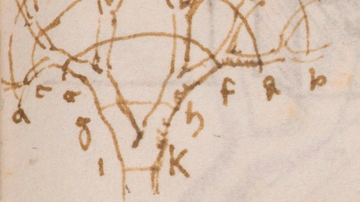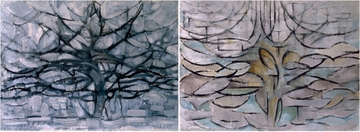Albuquerque is no stranger to fractals. The city is home to the Fractal Foundation, features fractal billboards around town, and even has a fractal hot air balloon, sponsored by the foundation. Fractals are infinitely complex patterns with never-ending detail as you zoom in. They can be created by repeating a simple process at finer and finer scales in an ongoing feedback loop.
Fractals play an important role in our community, but they also help explain how humans perceive objects, such as trees. New research from The University of New Mexico highlights how branch diameter scaling contributes to our perception of trees. The study, titled "Scaling in Branch Thickness and the Fractal Aesthetics of Trees", was recently published in the PNAS Nexus Journal. UNM Biology Professor Mitchell Newberry is the senior author.

Newberry has been researching tree-like structures in vasculature, focusing on branching structures such as tree branches, blood vessels, lungs and other fractal structures in nature. His new work combines science and math to explore artwork and explain how trees are perceived.
The research was inspired by applying the same measurement techniques used to assess living vasculature to artwork depicting trees.
"We measure branch diameter scaling in trees and it plays the same role as fractal dimension, because it shows how many more tiny branches there are as you zoom in," explained Newberry.
The researchers, Gao and Newberry, began by selecting a sample of artwork from around the world, including India, Japan, and Europe, and measured paintings using mathematical equations for scaling.
The artworks analyzed were L'Arbre de Vie (Tree of life) by Gustav Klimt (1909), a carved stone window screen of the Sidi Saiyyed Mosque in Ahmedabad, Gujarat, India (1573 CE), Cherry Blossoms by Matsumura Goshun (1752–1811) and two paintings by Piet Mondrian, De grijze boom (Gray Tree, 1911) and Bloeiende appelboom (Blooming Apple Tree, 1912).

In the artwork of the Sidi Saiyyed Mosque, the researchers found that the tree branches closely follow a rule described by Leonardo Da Vinci. Da Vinci's rule implies branch diameter scaling, with a scaling exponent of 2, whereas the exponent in the mosque is 2.5, closely matching real trees. The mathematical precision is evident in the art. The scaling exponent plays the same role as fractal dimension, in describing how much more complexity is present at finer scales as the tree branches.
"We took a mathematical theory that was designed for biology and used it to look at artwork over centuries," said Newberry. "Trees are a kind of fractal, and we've quantified that fractal nature in terms of this scaling exponent. What this tells us is how thick we can expect the branches to be and how many branches of any given thickness we expect to see."
The researchers took a clue from DaVinci's analysis of trees to understand that branch thickness was important.
The researchers also noticed a key insight in Piet Mondrian's paintings of trees. While painting trees over a 20-year time period, the 20th century abstract artist gradually removed elements from the trees. The famous painting "Grey Tree" uses only curved black brushstrokes on a plain background. The researchers nonetheless discovered that the black arcs follow branch diameter scaling, with an exponent of 2.8.

"If you show this painting to anyone, it's obviously a tree. But there's no color, no leaves or anything. You could maybe think about it as a silhouette, but there's no clear branching, it's just these disconnected sort of overlapping brush strokes. So how does Mondrian convey a tree using just a few lines?" asked Newberry.
A year after painting Gray Tree, Mondrian created another painting, titled Blossoming Apple Tree, that no longer follows branch diameter scaling, making it difficult to identify the tree.
"If you look at that painting, people see dancers, fish scales, water, boats, all kinds of things. People think it's just abstract lines. But the only difference between these two paintings—they're both black strokes on a basically gray background—is the branch diameter scaling. They're actually two paintings of the very same tree!" explained Newberry, "But you could only know that from looking at Mondrian's sketches and other work."
Without realistic branch diameter scaling, our perception of trees goes away, and this is a main reason that people are able to perceive trees. Trees do not have fixed proportions like architecture or the human form, because each time a new branch grows, it creates new ratios and proportions, but there is still a system of flexible proportions that are finely tuned.
"Mondrian's paintings show us that this branch diameter scaling description of trees is just so fundamental to how we perceive trees that, that if you take it away, you don't really see a tree anymore," said Newberry, "We begin to understand what it means to be a tree, what it means to see a tree."
The equations for describing branch diameter are not much more complicated than the Pythagorean theorem. "Da Vinci understood this to some extent," said Newberry, "but it took the concepts of fractals and self-similarity which were really not explored until the 70s to really understand the architecture of trees. That's the scaling piece." The researchers use the equations for branch diameter to derive the scaling exponent, which describes the fractal nature of tree branches. These mathematical equations are now being applied to art to show how humans perceive trees.
This research showcases the essence of trees from different perspectives, from the artistic perspective, to a biological perspective, and a mathematical perspective.
"Theorists, tree physiologists, artists and mathematicians all end up seeing the same thing in different ways," stated Newberry. "Specifically, when Mondrian made this 20-year study of removing everything you could remove from trees and still have it look like a tree, the last thing to go was also what mathematicians and tree physiologists thought was the most important."
While Newberry and his team do not speak for the artist's knowledge of mathematical equations for trees and fractals, he does say that artists had a keen and precise sense of proportion, and in this research, he shows it mathematically.
"Artists are always careful at observing things, so if you just look at a lot of trees, you end up getting a sense of the ever-changing proportions among the branches. But the math is interesting because it does give you kind of a benchmark to work against." Newberry goes on to explain that, "You could easily see the difference between scaling exponents of one and two and by extension, if you have a discerning eye, you can see the difference between 1.5 and 2, or 2 and 2.5."






